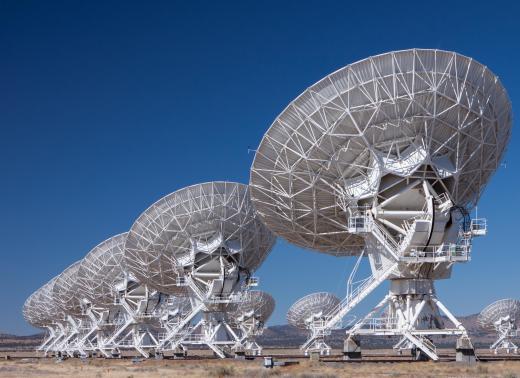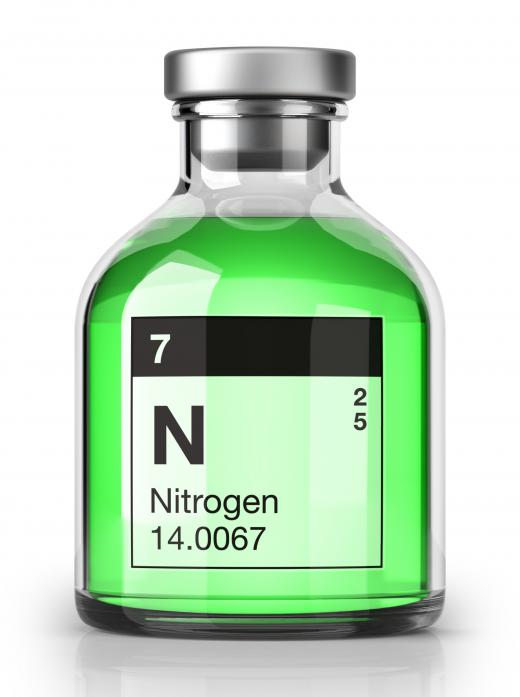What are Some Properties of Venus' Atmosphere?
 Michael Anissimov
Michael Anissimov
Venus, the second planet from the Sun, has an atmosphere about 96 times denser at surface level than the Earth's. Venus' atmosphere is composed of 96.5% carbon dioxide and 3.5% nitrogen, thought to be similar to the Earth's atmosphere approximately 4.4 billion years ago. In the Earth's case, most of the carbon dioxide was absorbed by the seas, precipitating out as carbonates, but Venus lacks surface water or biomass to sequester the carbon dioxide, so it remains airborne.
Venus may be considered as an extreme example of global warming, with an average surface temperature of 461.85 °C (863 °F). This is not just due to Venus' proximity to the Sun, but because of the "greenhouse effect" — the Sun can deliver heat to Venus' atmosphere, but it retains that heat due to the large amount of greenhouse gases — carbon dioxide, sulfuric acid — present. On Earth, which has an atmosphere 100 times less dense, more of the energy radiates away.

Although the surface of Venus may be considered one of the most uninhabitable areas of the inner solar system, at approximately 50-65 km (31-40 mi) above the surface, the temperature and pressure of Venus' atmosphere is similar to that of Earth's. Because the pressure is similar, balloons filled with breathable air (21% oxygen, 78% nitrogen) would float at this level as long as they remain structurally intact. Not only that, but the extremely slow rotation of the planet itself could be avoided. The equatorial clouds at this level rotate around the planet about once every 20 hours. A colony suspended here would be carried along by the wind, experiencing a regular night and day, much like people living on Earth. These factors have caused some space scientists to call this region the most habitable in the solar system outside Earth, trumping Mars.

Because the planet lacks its own magnetic field, Venus' atmosphere is constantly assailed by the solar wind. The charged solar wind strips away hydrogen, helium, and oxygen atoms, producing a long magnetotail composed of ions, extending many planetary diameters behind Venus.
Venus' atmosphere is filled with clouds of sulfuric acid, which reflect 75% of incoming light. Their many layers have historically served to obscure the surface of Venus, leaving humanity to speculate about the world beneath. Nothing was known of Venus' surface until the 1970s, when radar pulses were beamed at the planet by the 300 m radio telescope at Arecibo Observatory. This revealed surface features as small as 5 km (3 mi) in width.
AS FEATURED ON:
AS FEATURED ON:













Discussion Comments
@highlighter- NASA's Jet Propulsion Laboratory website has a few hundred photos of the Surface of Venus from Magellan. Magellan was able to capture over 98% of the Venus' surface in radar images in incredible detail. The surface mapping photos are also very detailed. The resolution of the surface mapping is approximately 100 meters per pixel, so features of just a few hundred square meters can be seen.
As for your thoughts on Venus evolving similar to Earth, I would say your hypothesis holds some weight. Venus has very few visible surface craters and based on the frequency of expected impacts for a planet with no moon, astronomers predict the surface of the planet has only cooled enough to become solid in the last 800 million years.
When Earth was 800 million years old, its atmosphere was somewhat similar to Venus. The Earth was mostly comprised of carbon dioxide and nitrogen, and the oceans had not yet formed. The atmospheric gases of both Earth and Venus originated from the planet's interior, and the oxygen in Earth's atmosphere did not appear until anaerobic bacteria began to form.
Many scientists believe that these types of bacteria were the first inhabitants of our planet because they could survive in an atmosphere void of any oxygen. Eventually the bacteria evolved to become photosynthetic, resulting in the release of highly reactive oxygen into the atmosphere.
Where can I find pictures of Venus with its atmosphere's layers peeled back? I would love to see these pictures. I have always thought that Venus could potentially become a planet very similar to ours in the next billion and a half to two billion years from now. Could my idea hold any credibility? Does anyone know anything about the evolution of the Earth's atmosphere in relation to the evolution of Venus' atmosphere?
From what I know, Venus could evolve very similar to Earth because it has very similar elements in its atmosphere. This runs contrary to the other planets in the solar system, especially those that have gaseous atmospheres like Jupiter, Saturn, Uranus and Neptune.
The one thing that I am hung up on is the fact that Venus has practically no oxygen in its atmosphere while Earth has plenty of oxygen in its atmosphere. Does anyone know if this would be a prevent Venus from one day evolving like our planet and possibly creating life similar to that on Earth?
What an interesting article. All of a sudden, I feel like I want to know more about the solar system I live in. In my astronomy class, we were talking about the Magellan probe that was sent to Venus in the 1990s. I was truly impressed with the ambitions of NASA during those days. The pictures were a stunning revelation of the surface of Venus.
The planet’s surface shows evidence of being very young. The planet is literally covered with volcanoes and rivers of lava longer than the Nile, Amazon, Yangtze or the Mississippi Rivers. Some of the volcanic landforms in the photos look like they could have been relics of some ancient extraterrestrial culture.
I know that this is not the case, but the landforms and the rivers of lava in these pictures are very artistic and emulate many patterns I see in nature on our own planet. The surface almost looks like the surface of places on our planet where the earth is still young in geologic terms.
Post your comments